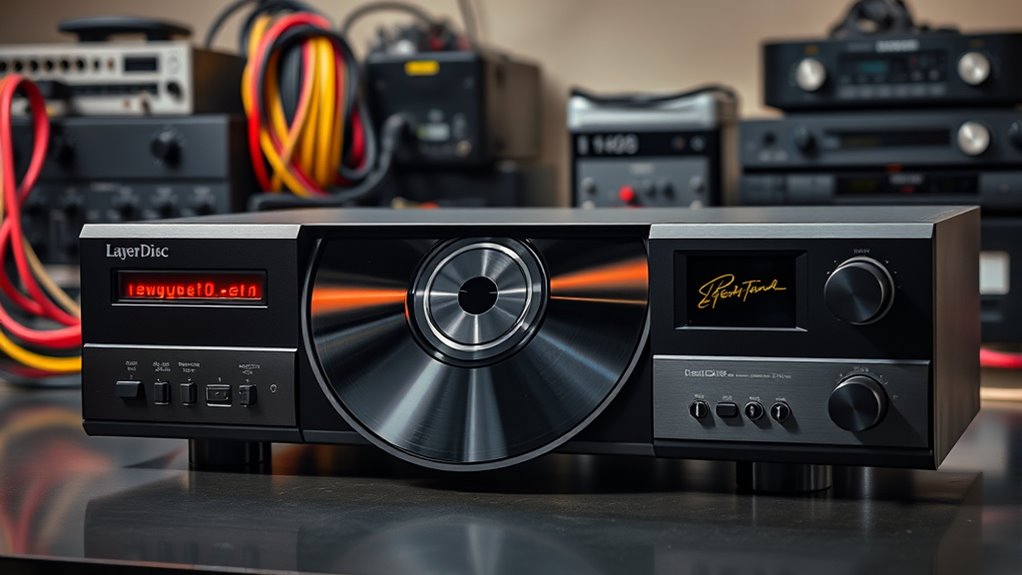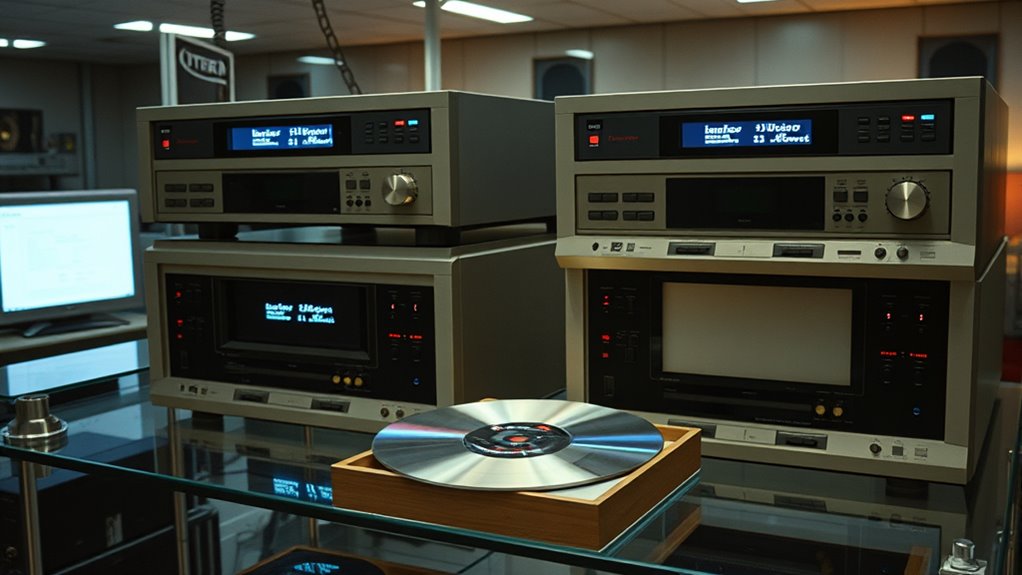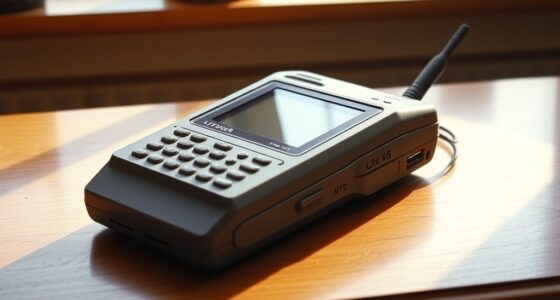LaserDisc players revolutionized home entertainment by offering superior analog audio and digital video, setting the stage for future formats like Blu-ray. They provided clearer pictures, better sound quality, and features like chapter navigation, making them true pioneers. Their sizable, reusable discs and high-fidelity audio influenced the development of later optical media. If you want to understand how these giants predicted the evolution of home entertainment, there’s more to discover below.
Key Takeaways
- LaserDisc technology introduced high-quality analog video and digital audio, laying groundwork for future high-definition formats like Blu-ray.
- Its large, durable discs and superior sound quality showcased early advancements in optical media that Blu-ray later built upon.
- Features like chapter selection and menu navigation in LaserDiscs anticipated the interactive capabilities of Blu-ray discs.
- LaserDisc’s focus on high-fidelity audio and visual quality influenced the development of subsequent digital high-definition media.
- Recognized as pioneers, LaserDisc players predicted the transition from analog to digital optical formats exemplified by Blu-ray.

LaserDisc players, once a popular choice for home entertainment, revolutionized the way people watched movies and listened to music. They offered a unique combination of high-quality video and audio that set them apart from other formats of their time. Unlike VHS tapes, LaserDiscs used analog audio and digital video stored on large, reflective discs, which provided clearer picture quality and better sound. You could enjoy movies with vibrant visuals and rich sound, all in one disc format that was durable and reusable. The disc formats used in LaserDiscs were primarily CD-based, but they differed in size and function, offering different capacities and features. This variety meant that consumers like you could choose discs optimized for movies or music, depending on your preferences.
LaserDiscs offered superior analog audio and high-quality digital video for immersive home entertainment experiences.
The analog audio component of LaserDiscs was a major selling point. It delivered superior sound quality compared to VHS tapes, with less noise and distortion, making it ideal for audiophiles and cinephiles alike. You could listen to music in high fidelity, with more accurate sound reproduction that preserved the nuances of the original recordings. For movies, the analog audio tracks provided immersive soundtracks, emphasizing dialogue, music, and special effects. This made LaserDiscs a preferred format for those seeking a richer audiovisual experience. The disc formats themselves, such as the standard 12-inch discs, were designed to maximize storage capacity and playback quality. They could hold up to about 60 minutes of video per side, which was quite substantial for the era and allowed for feature-length films without excessive compression.
You might have appreciated the physicality of LaserDiscs—the large, vinyl-like discs that you handled with care. Their format allowed for high-resolution video, which was a significant step up from the fuzzy images of VHS tapes. This high-quality analog video, combined with analog audio, created a viewing experience that many considered superior at the time. The disc formats also supported features like chapter selection and menu navigation, giving you more control over playback. Despite their bulky size, LaserDiscs became a collector’s item and a favorite among enthusiasts who valued quality over convenience. Additionally, the use of analog audio technology contributed to their reputation for superior sound fidelity compared to other formats.
In essence, LaserDisc players introduced you to a new level of home entertainment, blending advanced disc formats with high-fidelity analog audio. They laid the groundwork for future optical media technology, acting as a bridge between traditional analog media and modern digital formats. Even today, their influence is evident in how we value high-quality audio and video, making them true pioneers in the history of home entertainment systems.
Frequently Asked Questions
How Do Laserdisc Players Compare to VHS and DVD Quality?
You’ll find that laserdisc players offer better video quality than VHS, with sharper images and richer colors, though they don’t quite match DVD quality. Laserdiscs have higher resolution and less compression, but their format compatibility is limited compared to DVDs, which are more versatile and widely supported. Overall, laserdiscs sit between VHS and DVDs in terms of video quality, making them a unique choice for collectors seeking better visuals.
Are Laserdisc Players Compatible With Modern HDTVS?
Imagine you want to connect your vintage LaserDisc player to a modern HDTV. You might find that it’s not straightforward due to display compatibility issues. LaserDisc players generally lack modern connectivity options like HDMI, so you’ll need adapters or converters. While some models can work with newer TVs, compatibility isn’t guaranteed, and you may experience limited resolution or output issues. You’ll need to check your player’s outputs and your TV’s inputs to find a workable solution.
What Is the Average Price of a Vintage Laserdisc Player?
You’re curious about the average price of a vintage laserdisc player. Typically, the price range varies from around $50 to $200, depending on the model and condition. If you’re a collector, some units with rare features or in pristine condition can fetch higher prices, boosting their collector’s value. Keep an eye on online marketplaces and specialty stores to find the best deals and rare finds.
Can Laserdisc Players Play Other Formats or Only Laserdiscs?
Think of your laserdisc player as a dedicated library, mainly for laserdiscs. Most models only play those discs, but some have multi-region capability, meaning you can enjoy discs from around the world. They usually offer basic audio output options like analog or digital, but you can’t expect them to play other formats like DVDs or CDs unless they’re specifically designed for it. So, your laserdisc player stays loyal to laserdiscs alone.
What Are the Maintenance Requirements for Laserdisc Players?
To keep your laserdisc player functioning well, you need to regularly clean the lenses with a soft, lint-free cloth to prevent playback issues. Additionally, check the belts periodically for signs of wear and replace them if they become loose or cracked. Proper maintenance ensures smooth operation and prolongs the life of your player, so don’t neglect these simple tasks to enjoy your discs without interruptions.
Conclusion
LaserDisc players paved the way for modern optical media, standing tall like ancient giants whose shadows still loom over today’s technology. Though they’ve faded into history, their influence echoes in the sleek design and high-quality standards of Blu-ray. You can see them as the sturdy roots beneath a flourishing tree, reminding us that innovation often draws strength from the giants of the past. Without these pioneers, today’s cinematic experiences wouldn’t shine as brightly.









